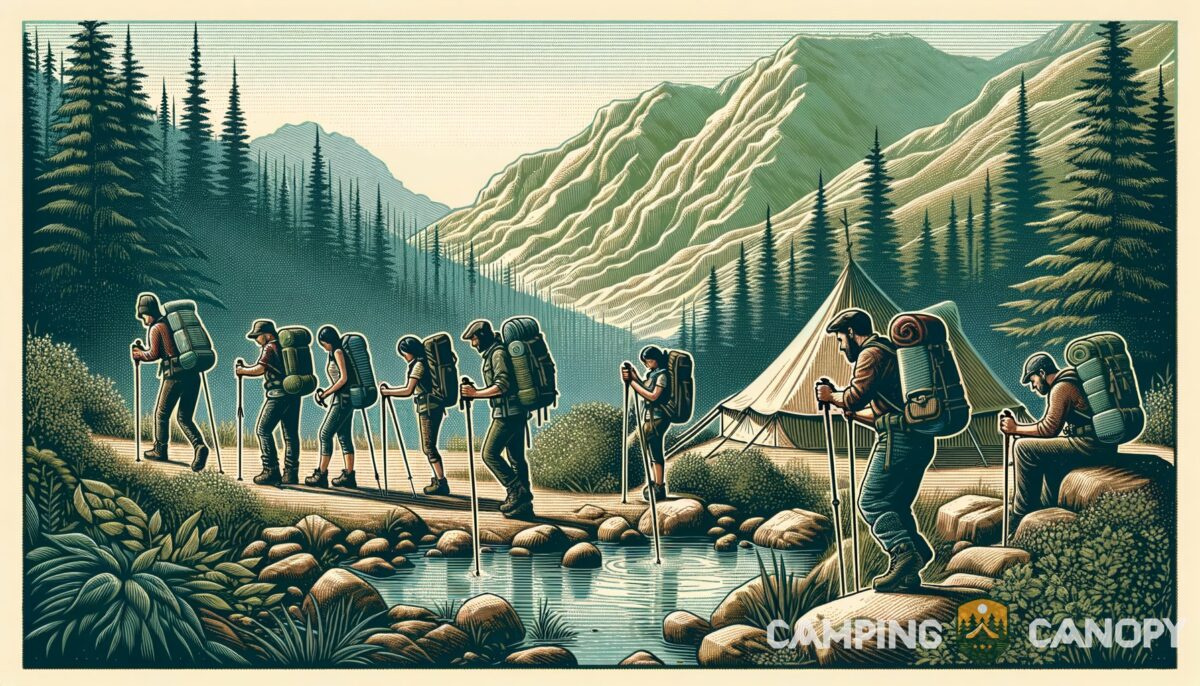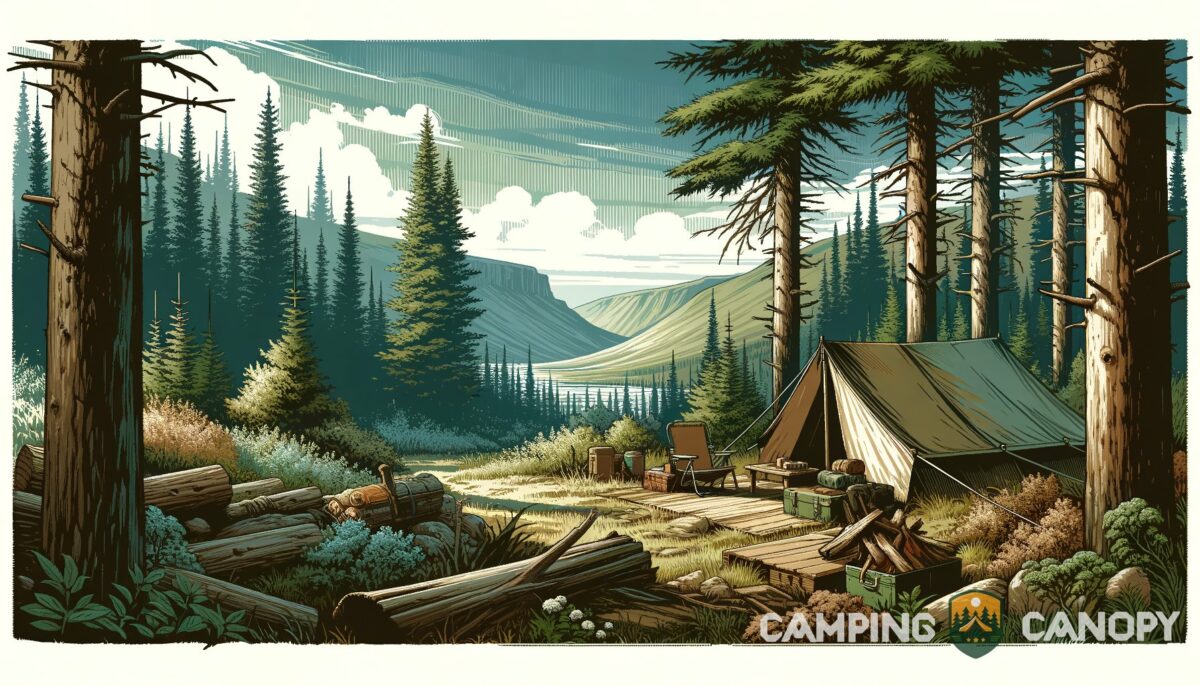I’ve always been a tad skeptical about hiking poles, thinking they were just another piece of gear to lug around. However, after diving deep into the benefits and hearing stories from the camping and hiking community, I’ve discovered they’re more than just walking sticks. This post unpacks the nuances behind their use and how they can actually elevate your hiking experience.
Key takeaways
- Hiking poles reduce stress on your body and increase your stability on the trail.
- They’re not just for walking—versatile uses include supporting tents and as emergency splints.
- Selecting the right type depends on your hiking needs and preferences in material, grip, and weight.
- Proper usage and care keep them effective and can prevent trail damage or personal injury.
Why do people use hiking poles?
Hiking poles, usually seen as essential gear among outdoor enthusiasts, serve multiple purposes for hikers of all levels. The reasons behind their widespread use are as varied as the landscapes we love to explore. Here’s a brief exploration into why these tools have become a staple in hikers’ packs.
-
Support and Stability:
- Reduces the impact on your knees and leg muscles by providing more support, especially during descents.
- Offers stability on uneven terrain, reducing the risk of falls and injuries.

Featured image for a blog post titled 'Why Do People Use Hiking Poles: How Can Trekking Sticks Enhance Your Outdoor Experience?'. -
Efficiency and Pace:
- Using hiking poles helps to distribute your energy expenditure more evenly, allowing for a steadier pace and reduced fatigue.
- Engages upper body muscles, making your hike more of a full-body workout.
-
Versatility and Utility:
- Can be used to probe the depth of water or mud, helping to gauge safety before crossing.
- Serves as a makeshift tool for pitching tents or tarp shelters, especially the ultralight variants that rely on poles for structure.
Engaging more of your body during hikes not only enhances your stability but significantly impacts the overall energy use, creating a more balanced and enjoyable experience.
While the utility of hiking poles stretches beyond mere support, adding them into your hiking routine can positively affect both your performance and enjoyment of the trail. This isn’t just about offloading the work from your legs to your arms but creating a rhythm that propers you forward, making those challenging inclines and tricky terrains a bit more manageable.
Selecting the right hiking poles
When it comes to choosing hiking poles, the multitude of options can be overwhelming. From materials to grips, each element plays a role in the overall functionality and comfort of the poles. Let’s break down what you need to consider.
Materials: Carbon vs. Aluminum
Materials are pivotal in the weight and durability of hiking poles. Carbon fiber poles are known for their lightness, which is a considerable advantage for long-distance hikers or those looking to minimize their pack weight.
However, they can be prone to breakage if put under too much stress. Aluminum poles, on the other hand, are slightly heavier but excel in durability and are typically more budget-friendly.

- Carbon Fiber: Best for lightweight, low-impact hiking.
- Aluminum: Suited for rugged terrain and more demanding conditions.
Pole grips: Cork, rubber, or foam?
Grip material is another crucial aspect, affecting both comfort and how well you can maintain your hold in different weather conditions.
- Cork Grips: Mold to your hands over time, offer excellent moisture resistance, and reduce vibration.
- Rubber Grips: Provide good insulation for cold-weather hikes but can lead to sweaty hands in warm conditions.
- Foam Grips: Absorb moisture well, making them ideal for hot weather, but they may wear out faster than the other options.
Adjustability and locking mechanisms
Adjustability is vital for accommodating different terrain and personal height. Most poles offer a telescoping feature with either a twist-lock or lever-lock (also known as flick-lock) mechanism. Lever-locks are generally more reliable and easier to use, especially with gloves on, but add a bit of weight compared to twist-locks.
- Twist-lock: Lighter, but may require more maintenance.
- Lever-lock: Heavier, but more durable and user-friendly.
Choosing hiking poles is about balancing the factors of weight, durability, and comfort to suit your specific needs. Whether you prioritize a lightweight setup for fast hiking or durability for technical terrains, there’s a fit for every hiker.
Can using different hiking poles be effective?
Mixing and matching different hiking poles, while unconventional, can indeed be practical. This strategy may arise from necessity, such as when a pole is lost or breaks, or from trying to balance weight and function. Carrying one lighter pole and one heavier, more durable pole can offer a compromise between minimizing exertion and ensuring stability on rough trails.
Hiking pole weight differences
The discrepancy in pole weights can affect your rhythm and balance. However, many hikers adapt quickly, and the benefits of having one extremely lightweight pole may outweigh the awkwardness. It is crucial, though, to test this setup on shorter hikes before committing to a long-distance trail.
Stability vs. Weight saving
The primary objective is always stability and support on the trail. If using two different poles significantly compromises this, it might not be worth the trade-off for the sake of saving a few grams. Conversely, the adaptability to use a lighter pole for most of the trek, switching to the heavier one for technical sections, can be a smart compromise.
Using two different hiking poles is a personal preference and can be effective with the right balance and adjustment. It epitomizes the ultralight backpacking ethos of tailoring gear to specific needs and preferences, even when it goes against conventional wisdom.
When to opt for or against hiking poles
While hiking poles have numerous benefits, they’re not always necessary for every hiker on every trail. Let’s dive into when they prove most beneficial and when you might leave them at home.
When to use hiking poles
- Long distances: Reducing fatigue and strain on your lower body is critical on extended treks.
- Technical terrain: For stability and support on rocky, uneven, or slippery surfaces.
- Downhill sections: To alleviate impact on knees and enhance balance.
When you might skip them
- Short, easy hikes: For trails without significant technical challenges or elevation changes.
- Dense vegetation or scrambling sections: Poles can become entangled or cumbersome to manage.
Deciding to carry hiking poles is a personal choice that should consider the nature of the trail, your physical condition, and personal preference. For some, the advantages in stability, support, and endurance are invaluable. For others, the freedom of movement without poles is preferable on less challenging terrains.
Understanding the Leave No Trace principles is also essential, ensuring that our use of hiking poles or any other gear minimizes our impact on the natural environments we cherish.
Choosing whether to use hiking poles involves considering the specific conditions of your hike and balancing the benefits of improved stability and support against the simplicity and agility of hiking unencumbered.
Tip: Choosing the Right Hiking Poles
Consider the type of hiking you’ll be doing most often. Lighter, carbon fiber poles are great for long distances, while aluminum poles are better for challenging terrains.
Alternate uses for hiking poles
While we’ve covered the traditional benefits and tips for using hiking poles, these versatile tools have more to offer. Think of them as Swiss Army knives—handy in several unexpected situations while exploring the great outdoors.
Makeshift monopod for photography
Turn your hiking pole into a monopod: This can stabilize your camera for that perfect landscape shot, especially helpful when you’re on uneven ground. Just secure your camera (there are special adapters for this purpose) to the top of the pole, and you’ve got yourself a makeshift monopod.

Tent and tarp support
Support for tents and tarps: In a pinch, a hiking pole can replace or supplement broken or forgotten tent poles. This is particularly valuable for ultralight backpackers who intentionally choose shelters designed for pole support.
Crossing streams and testing terrain
Testing terrain and depth in streams: Before you step into unknown waters or suspect ground, use your hiking pole to gauge depth and stability. This simple action can prevent a soaked boot or a twisted ankle.
Tip: Mixing Different Hiking Poles
If experimenting with poles of different weights, use the heavier pole in your dominant hand for better stability and balance.
On a solo hike through the Rockies, I found myself facing a river swollen with spring runoff. Without my hiking poles to test the waters and steady my crossing, I might have ended up downstream. They truly were my unsung heroes that day.
Chris, Founder of Camping Canopy
Dos and don’ts of using hiking poles
Properly using hiking poles enhances their benefits while reducing potential drawbacks. Here are some essential practices to keep in mind:
Dos
- Do adjust the pole length to match the terrain; shorter for uphill, longer for downhill.
- Do use straps correctly to enhance grip and reduce wrist strain.
- Do place poles in line with your footsteps to maintain a natural rhythm and balance.
- Do clean and maintain your poles regularly, especially after hikes involving mud or water.
Don’ts
- Don’t use poles with too much force, which can lead to premature wear or breakage.
- Don’t forget to retract your poles when not in use to prevent tripping others or damaging the pole.
- Don’t ignore the terrain; rocky or sensitive areas might require cautious use to avoid damage.
- Don’t over-rely on poles for balance; develop core strength to support your hiking stability.
Emergency situations
Emergency splints: If you or a hiking companion get injured, hiking poles can be part of an improvised splint, aiding in immobilization until further help can be obtained.
Advantages and disadvantages of hiking poles
Hiking poles can be a game-changer for outdoor enthusiasts, but they’re not without their drawbacks. Here’s a balanced look:
- Reduces stress on knees and leg joints, especially when descending.
- Improves balance and stability on uneven terrains.
- Increases hiking speed by incorporating upper body in the movement.
- Can be used for multiple purposes, such as support for ultralight shelters.
- Requires coordination and energy, which might be challenging for beginners.
- Can be cumbersome to carry and store when not in use.
- Over-reliance may lead to decreased balance skills without poles.
- Improper use can result in trail damage or personal injury.
Frequently asked questions (FAQ)
There are special adapters and mounts designed to attach cameras to poles, effectively turning them into monopods.
Not all shelters can be supported by poles. Check your gear’s compatibility, particularly if it’s designed for ultralight trekking.
Press the pole gently into the ground ahead of you. Its resistance offers clues about the terrain’s firmness and what lies beneath.
Yes, especially for unpredictable terrains or distances where their utility can outweigh the inconvenience of carrying them.
In combination with a sturdy material for stabilization, hiking poles can help immobilize a limb in case of injury.
While not a deterrent, they can provide a measure of distance or support if you need to make a loud noise to scare an animal away.
Final thoughts
In wrapping up, it’s clear that hiking poles are more than just an accessory for the trail—they’re versatile tools that can enhance your hiking experience in numerous ways. Whether it’s stabilizing your stride, upping your hiking speed, or serving as an essential component of your emergency kit, they earn their place in your pack.
For those new to the concept or looking to enhance their outdoor excursions, consider giving them a try on your next adventure. Don’t forget to brush up on Leave No Trace principles to ensure your adventures remain as respectful to nature as they are enjoyable for you.
















